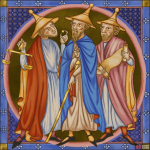Text
Jews settled in Moravia and Bohemia probably before the 10th century. They lived mainly around long-distance trade routes in major centres which in the early Middle Ages were: Olomouc, Brno, Znojmo and the central Elbe River environs. However, most lived in Prague in the Old Town.
They were under the legal protection of decrees by Wenceslas II and then ![]() Charles IV, as the rulers could develop the trade with their support. Over the century, however, the expansion of their activities in trade and finance gave rise to protests from many common classes, especially the Church. This was then reflected in folk rumours and resulted in repeated violence.
Charles IV, as the rulers could develop the trade with their support. Over the century, however, the expansion of their activities in trade and finance gave rise to protests from many common classes, especially the Church. This was then reflected in folk rumours and resulted in repeated violence.
As a result of the protests, their rights were restricted: they could not buy land or houses, had to live in restricted neighbourhoods, and they were only allowed to trade where they were not competitors to locals. They were also not allowed to work as craftsmen or farmers. However, they could lend money at interest (called usury), which was forbidden to the Christian population. Although only a part of the Jews engaged in this activity, it caused many social problems.
Segregation was also emphasized by the mandatory marking of the Jewish population - for example, they wore a yellow ring on their clothing, a hat of a different shape, women wore a yellow ribbon in their hair, and men had a mandatory beard. In addition, the Church traditionally blamed them for “murdering Christ” and maintaining pagan rituals.
In the Middle Ages, Jews were considered the “property of the king” and as such were protected by the king, so if the townspeople committed violent attacks against the Jewish community, burning their quarter and murdering the inhabitants (later termed “pogrom”), they had to pay a hefty “compensation” to the king. Some kings welcomed such attacks as a good source of income, others protected the Jews.


No Comments